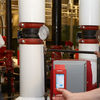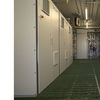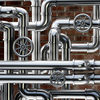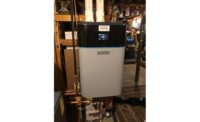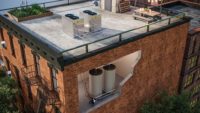Global warming, climate change and increased natural disasters have triggered water crises across the globe. The United States is not immune — just look at the situation that unfolded last year with Lake Mead, shared by Nevada and Arizona, and Lake Powell, between Utah and Arizona.
In response to water scarcity issues, some regions, such as the West and South, are adopting water reuse and rainwater capture solutions to manage and provide access to water.
"Water reuse is a multi-benefit solution that can help industrial and commercial operations save money, improve reliability and contribute to environmental resilience," notes Patricia Sinicropi, executive director of the WaterReuse Association. "Onsite recycling of the building’s own grey water or blackwater is one way to achieve these benefits. Another way is to use a municipal source of non-potable recycled water in your building, in locations where this is on offer. Onsite water reuse is becoming increasingly popular in traditionally water-abundant regions like the Northeast. In addition to reducing water demands, an onsite water reuse system can offer co-benefits such as managing surging stormwater flows and reducing impacts on aging sewer infrastructure."
According to Aaron Tartakovsky, co-founder and CEO of Epic Cleantec, a water technology company that deploys on-site water reuse systems into the built environment, "Our whole philosophy is there is no ‘waste’ in wastewater."
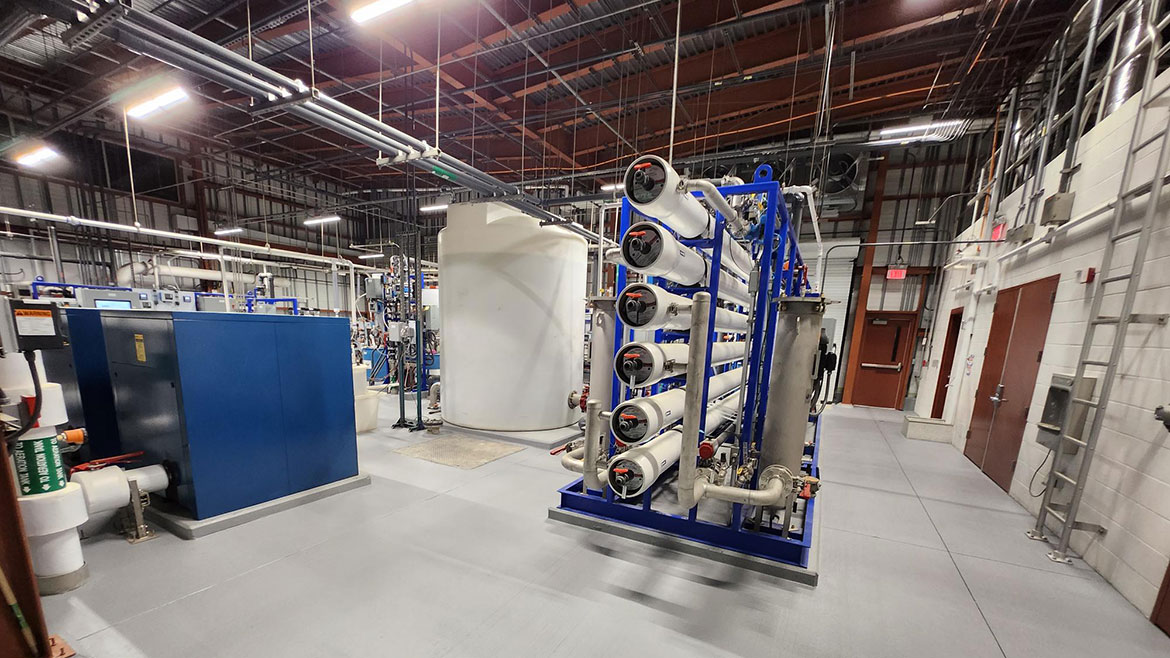
Piedmont Atlanta Hospital’s WaterHub, completed in early 2023, reclaims up to 250,000 gallons of wastewater per day and turns it into water used in the hospital’s cooling towers and boiler systems. Over the next decade, this wastewater recovery system could save up to 750 million gallons of potable water that would have otherwise been drawn from regional water resources. Image courtesy of Bob Salvatelli
Tartakovsky notes with on-site water reuse, you can actually reuse up to 95% of a building’s wastewater.
"There’s definitely a very sharp uptick in demand for this type of approach," he says. "Some of it is just driven by the market where green building is no longer a nice-to-have. It is now mandated by code. It is demanded by the market. Office spaces won't be able to get new tenants unless they are making sustainability a priority. So part of it is market demand, and then part of it is also regulatory. In many ways, you can think of water reuse where distributed energy was 15 years ago, which is to say we went from a sole reliance on centralized energy production to a more distributed model of solar, wind and hydro. I think water is having its ‘solar moment.’ We're just 15 years behind the energy folks. There's a big regulatory wave happening, and actually, where I'm based in San Francisco, is the epicenter of what we like to call this ‘water reuse revolution.’"
Tartakovsky adds that the technology to implement water reuse has been around for decades. His father, also one of his cofounders and an HVAC engineer by training, actually got his start in the space program.
We've had the technologies to do water reuse for decades. One of my co-founders is my father, who is an HVAC engineer by training, and he got his start in the space program. "As he often says, ‘What do you think the astronauts are drinking in space?’"
"We have technologies to treat water. Really, the problem has been regulations and building codes. If you are developing a new project, and you want to do all these different sustainability cutting-edge technologies, if it turns out that water reuse is just going to be prohibitively complicated to do because The Department of Public Health and Building Inspection and all these other folks aren't on the same page to how to permit these things. San Francisco came up with a playbook, and actually, every new building over 100,000 square feet in San Francisco has to have an on-site water recycling system. San Francisco basically developed this playbook, which is now largely being replicated in other cities and other states."
Pete Munoz, PE, LEED AP, EcoDistricts AP, senior engineer and practice lead at Biohabitats, notes that he has seen water reuse systems adopted somewhat regionally. “Certainly, California has a lot of water reuse systmes, and this is partly due to interest from the drought. It’s also due to California passing a grey water code tha tfor certain projects of a certain scale, made it really easy to permit. However, that doesn’t really translate over into Nevada or Arizona. But in general, people in the Southwest have been more interested in water reuse. Our work tends to follow high-performance buildings, which if you look at where buildings are being built right now, that tends to be in the South or Southeast. So Texas, North Carolina, Atlanta, that's where cities are growing, where there's a lot of construction and where some water reuse is happening.”
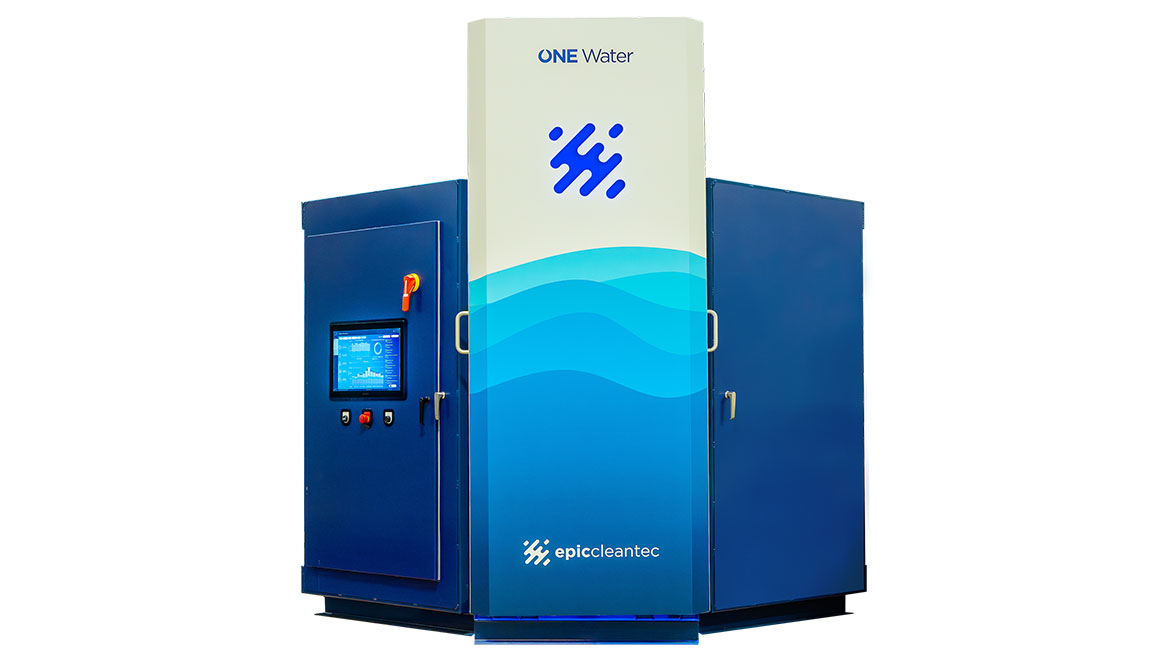
Epic’s OneWater system can safely recycle up to 95% of a building’s wastewater — either blackwater or greywater — and produces recycled water that can be reused directly onsite for non-potable applications like cooling towers, toilet and urinal flushing, irrigation or clothes washing; recovered energy from wastewater heat can be captured and used to preheat domestic hot water supply; and repurposed natural soil amendments that can be used in landscaping projects, gardens or even local parks. Image courtesy of Epic Cleantec.
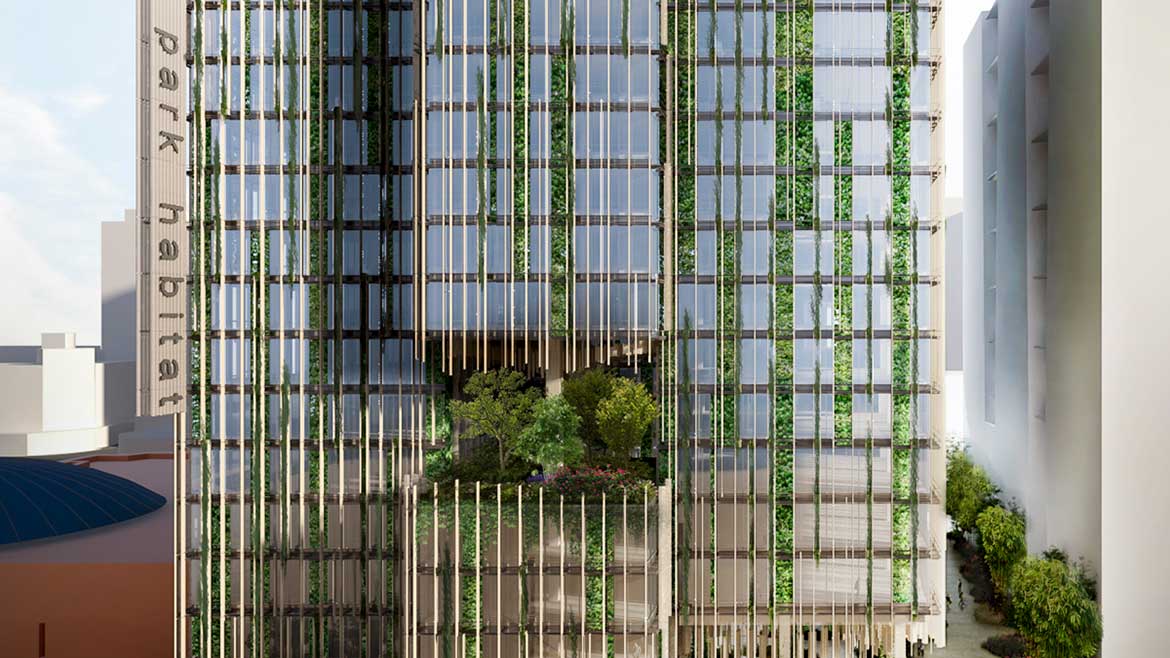
Epic Cleantec’s blackwater treatment approach will reuse nearly 11 million gallons of water per year for Park Habitat, a multi-purpose building in San Jose, California. Image courtesy of Westbank
Randy Booker Jr., Ph.D., P.E, senior vice president, Gresham Smith, notes that he is definitely seeing an uptick in interest of recycling and reuse of wastewater resources. “I would say it’s more on the industrial client side. Most of our clients are in the relatively water-rich South and East, but on the industrial sie, we’re seeing an interest in reuse and recycling from a couple of perspectives. One of which is water scarcity, water cost and then there's a resiliency aspect to that, which is providing an alternative supply of water should your municipal government or your local utility supply be interrupted. You can reuse your wastewater.”
Barriers to adoption
As Tartakovsky previously mentioned, water reuse technology has been around a long time, so why aren’t there more systems in use?
"Honestly, one of the biggest challenges that has slowed adoption to date has just been regulatory," Tartakovsky explains. "It’s not clear how these systems were be permitted, engineered and installed, and then operated and maintained. But the regulatory blockers are starting to move away in some areas."
Tartakovsky adds that with any newer technology, there’s always going to be the first adopters.
"There’s always going to be the first adopters to show everyone else that not only is the water safe, the systems are easy to install and they actually save money," he says. "There's been a few of these onsite grey water/blackwater systems throughout the country, but it's generally been more one-off approaches. What we're seeing now is that after this first wave of projects is coming online, that now serves as a model for other owners, other developers, architects, contractors and engineers who can actually come visit these systems. They say, ‘OK, wow, this is cool. It's sustainable, and it saves our clients money, so it's just a win-win-win situation.’ We're starting to see these take off more."
Munoz points to two principal reasons why people don’t reuse water. “One is purchasing water is really cheap in most areas, so saving water is not a very lucrative thing. No. 2 is water infrastructure is really expensive to maintain and operate, and that goes back to the jurisdiction. For example, if I’m in Oregon and I want to reuse wastewater to flush toilets in an office building, I have to sample that water every single day, and I have a whole host of parameters I have to check. I also need a licensed operator to manage that whole system, and not necessarily take those samples, but the sampling cost alone is significant. Then I've got to report that monthly and then do an annual report for that. On the flip side, if I'm a small residential community, like an apartment building that just wants to do grey water for toilet flushing, then it's an entirely different permit process. I have to sample once a month or once a quarter, and my operations are not very arduous. Both of them are flushing toilets, but they have different requirements. That’s just Oregon specific, and it’s totally different in other parts of the country.”
The ‘yuck factor’ and public perception also plays a role, Booker notes. "Looking at the treatment of wastewater and sewage, and then turning it into something that could be potentially adjacent to public access or in direct reuse situations, consumption — there’s definitely a perception issue that plays into it, though I do think that it’s increasingly going away."
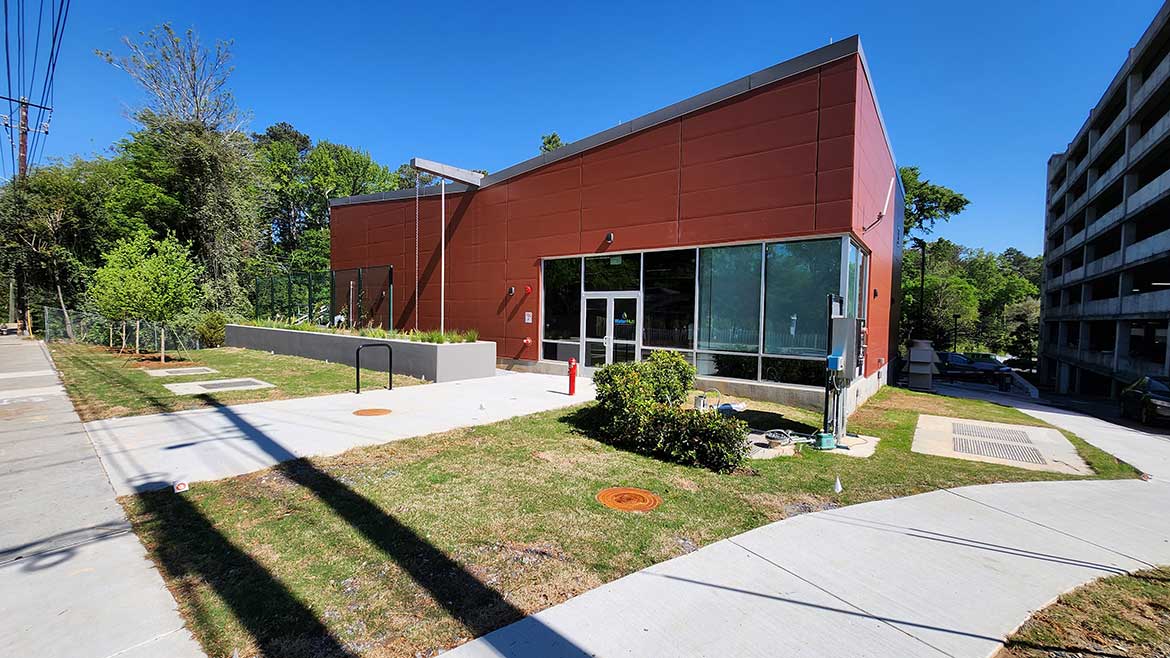
One of the challenges in designing the Piedmont Atlanta WaterHub was its compact size, just 4,000 square feet. The building replaced eight parking spaces and a parking median. Image courtesy of Bob Salvatelli
Success stories
One project Tartakovsky is especially proud of is Park Habitat, a planned 1.3 million square foot office space, retail shopping center and museum in San Jose, California.
“The project is completely enveloped on literally every façade with green life,” he notes. “Not only do they have 20 sources of living wall in the building, but throughout the building, they have these podiums where you have parks — the architect is trying to blur the lines between nature and the built environment. What is very cool in a place like California, where droughts are becoming more frequent, more prolonged and more extreme, it’s hard to be able to justify that we’re going to shroud this entire building in water intensive green life when we have these water challenges. But this project is actually going to incorporate a 30,000 gallon per day blackwater recycling system, where not only are we going to be capturing that water, treating it, and then reusing it to actually irrigate all of this greenery, but we're also stripping out the organics from the wastewater, those food and human waste organics, and converting those into different soil products that we can use locally.”
Epic Cleantec’s OneWater system safely treats and recycles water onsite for non-potable reuse applications like toilet and urinal flushing, cooling tower makeup, irrigation and clothes washing. Leveraging a multi-barrier approach that includes ultrafiltration membranes and state-of-the-art disinfection systems, the OneWater system produces a highly purified final product that is guaranteed to meet regulatory requirements for interior and exterior recycled water reuse, meeting disinfected tertiary reuse effluent standards. The system is also fully automated with remote monitoring.
Munoz has worked as a collaborator with PAE Engineers on a lot of high performance buildings. So, when PAE was looking to build its new Portland headquarters, the PAE Living Building, the firm turned to Biohabitats for help.
“We knew PAE really wanted to push the boundary in water and waste infrastructure,” Munoz explains. “We had worked with them some on the Bullitt Center in Seattle — we weren’t the primary water engineer on that one, but we help advise on a few of their systems, did some early concept work and then helped advise on the operation of the system. There were a lot of lessons learned from that building, and we wanted to incorporate those into this building in Portland for them, partly because it was almost identical in terms of the size and program.
“It was a quarter acre lot, five-story office building,” he continues. “PAE is the main tenant in the building, so it was very similar. It has some of the same systems — composting toilets to treat all of the wastewater, a grey water treatment system for flushing toilets, a rain harvesting system for the entire potable water supply. Those are the three that are similar to Bullitt Center, at least in approach, not necessarily in design. But the fourth system is a little unique for PAE, and that is we are diverting all of the urine that is collected in the building and we are creating fertilizer on site. It’s one of the first buildings in the world to do that. So we're creating a retail grade fertilizer — it's an ultra-pure ammonia, nitrogen-based fertilizer that we're producing and packaging on the first floor of the building.”
All 100% of the water demand of the PAE Living Building is collected and treated onsite. All water used in the building is supplied by captured rainwater or reused grey water for non-potable needs. The building only uses municipal water for the fire protection systems and sewer pipes where the rainwater tank greywater overflows to the existing infrastructure.
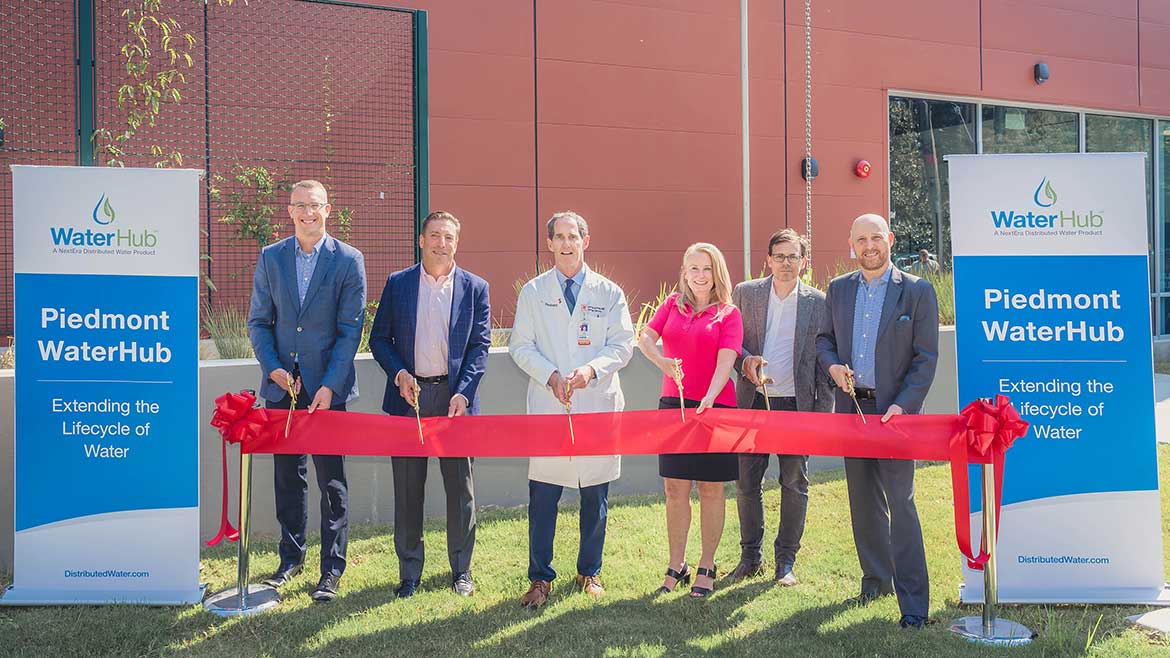
Piedmont Atlanta's WaterHub works by using biological treatment and advanced filtration technology to naturally break down organic matter in wastewater, enabling its use for non-potable, or non-drinking, purposes. It is specifically designed to suppress odors that are typical in wastewater treatment. Image courtesy of Bob Salvatelli
Booker and his colleague Alexander Sharp, P.E., senior water resources engineer at Gresham Smith, worked on the Piedmont Atlanta Hospital WaterHub project, which was completed early last year. The hospital wanted to conserve water and hedge against rising rates.
“The facility known as the WaterHub is projected to help Piedmont Atlanta reclaim up to 250,000 gallons of wastewater per day from the hospital and turn it into water that can be used in the hospital’s cooling towers and boiler systems,” Sharp explains. “Over the next decade, this wastewater reclamation could save up to 750 million gallons of potable, or drinking-quality, water that would have otherwise been drawn from regional water resources. This water will not be used for the hospital’s drinking water supply. For that use, the hospital will continue to receive water from the City of Atlanta Department of Watershed Management, as it always has.”
Sharp notes the basic concept is to collect wastewater from the hospital campus.
“The system has three locations where we're mining the wastewater from existing sewers and taking that into the treatment system, called the WaterHub. We process all the trash and debris out of the wastewater, and then we treat that biologically to remove the pollutants that are in the water. It uses a relatively advanced biological treatment process called a membrane bioreactor. And essentially, we've got these membranes that are actually immersed in the wastewater, and we suck out basically filtered water. That's pretty clean water in and of itself, but then we disinfect it using ultraviolet reactors. Then we further process it through a more advanced membrane system called reverse osmosis. We add a little bit of chemical to provide a disinfectant residual — that’s important when you're sending it out to a distribution system where there may be contact with humans, or in the cooling towers, you get the drift from the cooling tower, which is the fine aerosols. From that aspect, we need to meet all the safety requirements and requirements that the state has on reclaimed water. From the WaterHub, we pump it to the two utility plants, and then we've got systems that deliver that as those cooling towers or boilers have a demand for the water.”
Key considerations for engineers
Engineers need to stay updated on the latest building codes and regulations, as well as educate clients on the benefits of water reuse systems.
"When quantifying the savings from an onsite water reuse system, it’s important to remember that you usually save money on both your water and sewer bills," Sinicropi notes. "Onsite water reuse systems also offer long-term benefits to resilience and reliability. For example: in the case of an unexpected interruption to municipal water supply, an onsite water system can continue operating."
Additionally, certain cities such as New York and San Francisco have dedicated grant and incentive programs for onsite water reuse systems, she adds. "Many other water utilities may offer case-by-case incentives under the umbrella of their water conservation programs."
Sinicropi adds some additional considerations for engineers include: “If the water is being used for non-potable purposes with the potential for human contact — such as toilet flushing, landscape irrigation or vehicle washing – then it is important that clear signage is displayed at the point-of-use, and that trainings are provided to maintenance staff. The specific requirements of signage and trainings are usually provided by the local water utility. The use of recycled water in a building is also a fantastic opportunity for environmental education. In addition to signage and trainings, there may be an opportunity to bring in a speaker from the local water utility or another expert to explain the benefits of recycled water to occupants.”
According to Tartakovsky, step one is to understand the regulatory landscape in any given market. "Do they already have a program in place, or are we going to have to work with the state public health authorities and state water regulators to do this?"
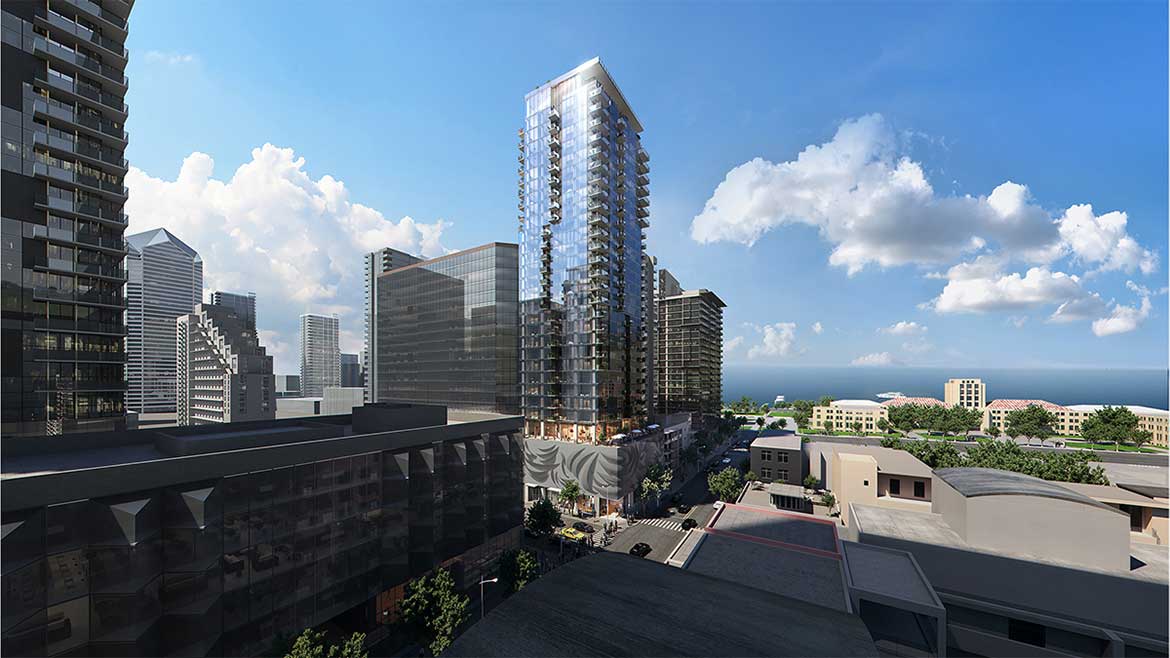
Epic Cleantec’s OneWater will reuse roughly 5.5 million gallons of blackwater per year for 601 W. Beech Street, a 33-story residential building in San Diego, California. Image courtesy of Forge Development Partners
Step two is to conduct a water budget. “We’ll look at the entire project and calculate how much wastewater they are producing and potential non-potable uses for that water,” Tartakovsky explains. “You could have two identical projects, but one of those projects has a giant irrigation demand. They have a park as part of the project, and all of a sudden, you have that non-potable use. So we always do a water budget to see what are our sources of wastewater, and what are the potential applications for that treated wastewater? That second piece also will help determine the ROI. Those are the two initial main considerations, and then we can determine whether the types of systems (rainwater, grey water, blackwater) and we can really tailor the approach to what makes the most sense for the client. From there, it's just coordinating with all the various stakeholders in the project.”
Because the nature of these systems, given the direct public health implications, there are very robust public health regulations that govern the design, installation and safe operation, and buildings are required to do a certain amount of testing where samples are taken and sent off to a lab, Tartakovsky adds.
"Our systems have over 100 different sensor points where we’re testing the water quality in real time," he explains. "We have 24/7 real-time analysis of what’s going on with that water, and we can actually operate and maintain these systems remotely, as well. We basically have full granular understanding of everything happening with the system, and then we have that second layer of working with the regulators, where we have third-party certified labs who are constantly testing the water. We have very well-trained members of our team, certified water/wastewater operators who know how these systems work. Just like any other building system, it's just all about the proper initial installation, and then preventative maintenance. It's knowing all the different steps to take to make sure that these systems not only work on day one, but are going to continue working well for the next 20 years."
Munoz notes that one of the biggest lessons learned at the PAE Living Building, is a lot of buildings use cast iron pipe to convey waste.
"Cast iron is a big water reuse no-no," he notes. "We need to stop doing that because what happens is it adds iron to the water, and iron basically makes UV disinfection impossible. We had to install an iron filter on our gray water reuse system at the PAE building because there was too much iron in the water to flush toilets to meet our specific permit. It was interesting because we have tons of water reuse systems that have cast iron pipe, but they weren’t regulated to the specific levels that we are in Oregon. So Oregon is the first system where it reared its head and became problematic. That doesn't mean the other systems don't have issues with the disinfection, they're just not to the level that you need to do in Oregon.
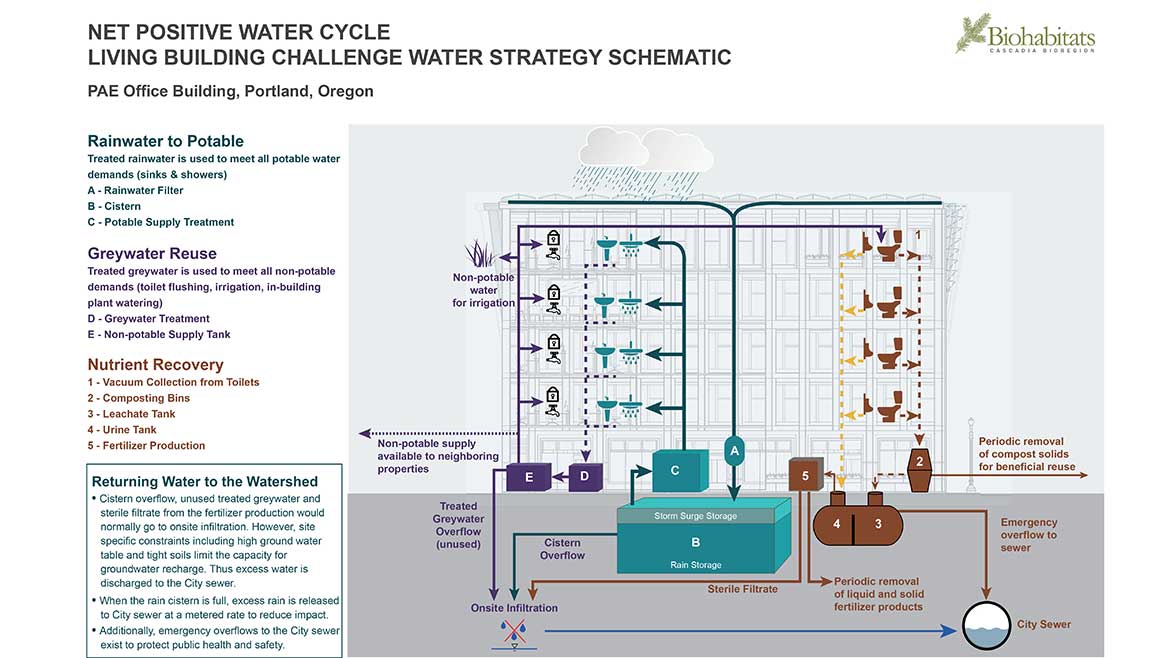
The PAE Living Building in Portland, Oregon, has 100% of its water demand collected and treated onsite. All water used in the building is supplied by captured rainwater or reused greywater for non-potable needs. Image courtesy of Pete Munoz
"Everything downstream of your water use is contributing to the water quality that's coming at you," Munoz continues. "Using iron pipe, if you're draining a green roof, you're going to have a lot of nutrients and sediment. If you have floor drains on floors that you're waxing or something, or you have a mop sink where you know you're going to wax the floor and they're going to dump that mop bucket into a mop sink. If I had the choice and I was going to do an on-site treatment system, and I didn't need to catch every drop of water, I would plumb the mop sink directly to the sewer, like bypass. If you can segregate your most dirty waste streams and really provide a consistent water source for your system, that's advantageous. So we're certainly doing more of that source segregation."
There are additional challenges and considerations when adding a water reuse system to an existing building, like the Piedmont Atlanta Hospital.
"There was the challenge with the site itself, the treatment system was a new building and tanks," Sharp says. "We had to build the structure that housed all the equipment on top of the wastewater tanks. The wastewater tanks are primarily underground, and then everything else is on top. So it's stacked. It's very compact. We didn't have much space between the setbacks from the existing roadways, entrances to parking decks, property lines and other parking deck structures. By the time you took all the required setbacks that are required from the city, our building just fit into this little space — we didn't have any space to spare, literally. Getting in the pipes from our collection points was also a challenge. They had to shut down one of the major roads and rebuild a manhole and put in connecting pipes. There were a lot of impacts on traffic and accessibility.
“Then, getting the pipes in to distribute the reclaimed water back into the hospital was a challenge because you've got all these existing buried utilities underground,” he continues. “So construction-wise, you’ve got to thread your way through all of that and not disrupt any activities that the hospital has or any of their utilities, like fiber optic cable, which is pretty important. Getting into those existing utility buildings and rooms was difficult, and once we got in there, we had to route around. The old utility building is pretty cramped, and just finding space to route the pipes and the valves and the instruments we had to put in to make the connections, that in and of itself was just a challenge.”
As water scarcity continues to worsen and challenge the built environment, water reuse projects will become more and more common.
“It’s a very exciting time in the water industry,” Tartakovsky says. “When it comes to how cities have been designed, it really hasn’t changed in thousands of years. We’re still using the basic design principles of the ancient Romans, who had this centralized water and wastewater infrastructure model. Then, of course, the modern sewer systems were popularized in cities like London and Paris, where people still love to go do the sewer tours of London and Paris. For us, we look around and we see buildings globally use 14% of all potable water, and almost no buildings reuse that water. Why? That's what we went out to tackle. I think the exciting piece is that organizations like IAPMO are really starting to embrace it. Water reuse is no longer just some kind of fringe approach that only environmentally-minded owners are pursuing, but now this is becoming mainstream, where even the most hardened owners and developers to the climate action wave are embracing these technologies because it just makes financial sense. That was a long-winded way of saying it's an exciting time to be doing what we're doing.”


